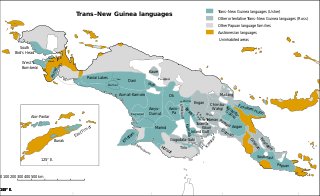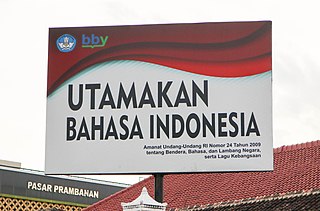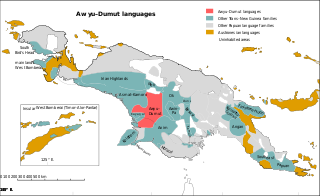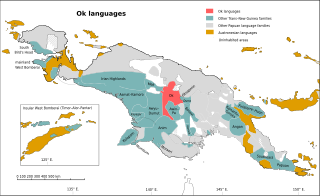Related Research Articles

Trans–New Guinea (TNG) is an extensive family of Papuan languages spoken on the island of New Guinea and neighboring islands, a region corresponding to the country Papua New Guinea as well as parts of Indonesia.

The Dani are an ethnic group from the Central Highlands of Western New Guinea in Baliem Valley, Highland Papua, Indonesia. Around 100,000 people live in the Baliem Valley, consisting of representatives of the Dani tribes in the lower and upper parts of the valley each 20,000 and 50,000 in the middle part. The areas west of the Baliem Valley are inhabited by approx 180,000, representatives of the Lani people, incorrectly called "Western Dani". All inhabitants of Baliem Valley and the surrounding areas are often called Dani hence they are also sometimes conflated with other highland tribes such as Lani in the west; Walak in the north; Nduga, Mek, and Yali in the south and east.

The Trans-Fly–Bulaka RiverakaSouth-Central Papuan languages form a hypothetical family of Papuan languages. They include many of the languages west of the Fly River in southern Papua New Guinea into southern Indonesian West Papua, plus a pair of languages on the Bulaka River a hundred km further west.
Bayono–Awbono is a recently discovered Papuan language cluster spoken in Papua Province, Indonesia, to the south of the Somahai languages. All that is known of them is a few hundred words recorded in first-contact situations recorded in Wilbrink (2004) and Hischier (2006).
Wambon is a Papuan language of Papua, Indonesia.
Aghu, or Central Awyu, is a Papuan language of South Papua, Indonesia. It may actually be two languages, depending on one's criteria for a 'language'. The two varieties are: Mappi River Awyu (Aghu) and Pasue River Awyu.
Elseng is a poorly documented Papuan language spoken by about 300 people in the Indonesian province of Papua. It is also known as Morwap, which means "what is it?" ‘Morwap’ is vigorously rejected as a language name by speakers and government officials.

More than 700 living languages are spoken in Indonesia. This figure indicates that Indonesia has about 10% of the world's languages, establishing its reputation as the second most linguistically diverse nation in the world after Papua New Guinea. Most languages belong to the Austronesian language family, while there are over 270 Papuan languages spoken in eastern Indonesia. The language most widely spoken as a native language is Javanese.

Papua New Guinea, a sovereign state in Oceania, is the most linguistically diverse country in the world. According to Ethnologue, there are 840 living languages spoken in the country. In 2006, Papua New Guinea Prime Minister Sir Michael Somare stated that "Papua New Guinea has 832 living languages ."

The Greater Awyu or Digul River languages, known in earlier classifications with more limited scope as Awyu–Dumut (Awyu–Ndumut), are a family of perhaps a dozen Trans–New Guinea languages spoken in eastern West Papua in the region of the Digul River. Six of the languages are sufficiently attested for a basic description; it is not clear how many of the additional names may be separate languages.

The Kamula–Elevala languages are a small family of the Trans–New Guinea languages spoken in the region of the Elevala River.

The Ok languages are a family of about a dozen related Trans–New Guinea languages spoken in a contiguous area of eastern Irian Jaya and western Papua New Guinea. The most numerous language is Ngalum, with some 20,000 speakers; the best known is probably Telefol.
Kombai (Komboy) is a Papuan language of Boven Digoel Regency in Indonesian New Guinea. It is spoken by the Kombai people. Tayan is a dialect.
Shiaxa (Sjiagha) and Yenimu, together known as South Awyu, are a Papuan language or languages of Papua, Indonesia. Whether they constitute one language or two depends on one's criteria for a 'language'. The two varieties are,
Pisa, also known as West Awyu and Asue Awyu, is an Awyu language of South Papua, Indonesia.
Mandobo, or Kaeti, is a Papuan language of Mandobo District in Boven Digoel Regency, South Papua, Indonesia.
Towei (Towe) is a Western Pauwasi language of West New Guinea. It is spoken in Towe Hitam village, Towe District, Pegunungan Bintang Regency.
The Brazza River is a river in Papua province, Indonesia. The Brazza River has its source at over 3000 meters of elevation in the Jayawijaya or Maoke Mountains of central Papua in Yahukimo Regency and flows south to the lowland rainforests of Asmat Regency before meeting the Pulau River, which flows southeast to the Arafura Sea.
Edera or Edera River Awyu is a Papuan language of Papua, Indonesia, spoken along the Edera River. It is closely related to Kia River Awyu.
Kia River Awyu, or Jair (Djair), is a Papuan language of Papua, Indonesia, spoken along the Kia River. It is closely related to Edera River Awyu. Upper Kia River Awyu and Lower Kia River Awyu may be distinct languages, depending on one's criteria.
References
- ↑ "New Guinea World - Awyu". Archived from the original on 2020-02-12. Retrieved 2020-03-31.